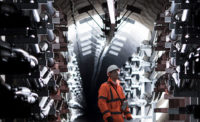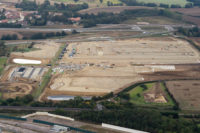As it leaves the European Union at the end of this month, the U.K. will begin re-erecting barriers to trade between itself and 27 remaining member nations that have been painstakingly taken down since the 1970s. But U.K engineers will keep in step with their continental counterparts as new structural Eurocodes begin to emerge this year.
While British electors voted in a 2016 referendum to leave the E.U., the influence of U.K. engineers over Eurocodes remains strong. Ten Eurocodes set out technical common rules common for building and civil engineering structural design.

The man overseeing Eurocode creation is Steve Denton, head of civil, bridge and ground engineering at multinational engineering consultant WSP’s U.K. arm. British engineers have “very good representation” in the numerous teams around the continent working on the upcoming new Eurocodes, he adds.
Denton is now in his third consecutive three-year period as chair of the European Committee for Standardization’s (CEN) team responsible for structural codes. Technical Committee 250 (CEN/TC250), which he chairs, will this year start publishing documents that will update and extend the first set of standards, which came into effect a decade ago.
Now covering an estimated 500 million people in Europe alone, Eurocodes emerged from a process of aligning standards that started in 1975 and was aimed at eliminating trade barriers across the community.
The Eurocodes deal with the basis of design, loading, main structural materials, seismic design and geotechnics. They are split into a total of nearly 60 parts, each with its own Nationally Determined Parameters, allowing adjustments to local conditions and practices, for example on safety and environment.
In 2010 the codes became mandatory in the region for all public funded projects, while conflicting national standards were stood down. Eurocodes apply to the E.U.’s current 28 member states along with Iceland, North Macedonia, Norway, Switzerland, Turkey and Serbia. Eurocodes are said to be in use across Asia and Africa and are being adopted in Middle East.
Work on the Eurocodes’ soon to emerge second iteration took off in 2012, when the European Commission mandated CEN to develop the current improved set of documents. A key task is to make existing Eurocodes more user friendly. “It’s a major suite of documents and there is some complexity,” say Denton.
The new codes will also reduce the number of Nationally Determined Parameters and, for the first time, cover structural glass and start work on structural membranes and fiber-reinforced polymers. They will also cover atmospheric icing as well as the actions from waves and currents on coastal and marine structures.
Creating these codes is a gargantuan task involving more 70 teams of specialists—typically five members—scattered all over Europe. “Hundreds and hundreds of meetings over recent years” have produced thousands of pages of technical document, says Denton.
Draft technical documents move up the CEN hierarchy, overseen by Denton, allowing member states to seek amendments before formal voting that seals final texts. The undertaking requires “a really major organization,” says Denton. “It’s the responsibility of the chair to try to achieve unanimity”. In his seven years as chair he has overseen more than 200 decisions without objections, he says.
After the U.K. finally bows out of the E.U., the government must negotiate new trading, security and numerous other agreements with the European Commission, which must be acceptable to the governments and parliaments of all 27 remaining members nations. British Prime Minister Boris Johnson says he will not seek an extension to negotiations beyond the previously agreed transition period ending on Dec. 31, 2020.
With that cliff edge looming, the nature of the future U.K.-E.U. relationship remains uncertain in many key areas. But since the British Standards Institution has committed to remaining in CEN, Eurocodes at least will continue to apply, ensuring the U.K.’s adherence to harmonized design. Denton welcomes this outcome. “Standardization is a really important activity in breaking down barriers to trade,” he says.




Post a comment to this article
Report Abusive Comment